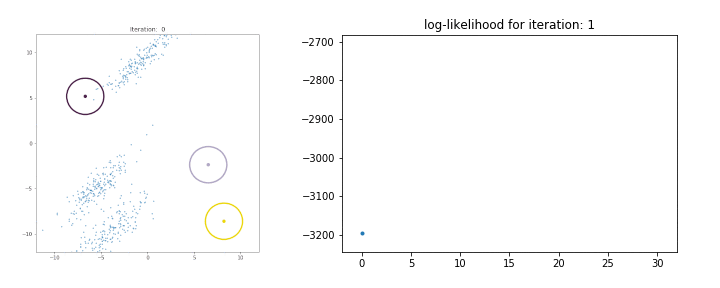Python implementation of Expectation-Maximization algorithm (EM) for Gaussian Mixture Model (GMM).
Code for GMM is in GMM.py. It's very well documented on how to use it on your data. For an example and visualization for 2D set of points, see the notebook EM_for_2D_GMM.ipynb.
- Numpy
- Scipy
- Matplotlib
class GMM:
- Parameters:
k: Number of clustersdim: Dimensionmu: Means of all clusterssigma: Covariance matrix of all clusterspi: Proportions of each cluster in P(x)colors: Colors for each cluster for plottingz: Latent variable Z (defined during EM init)num_points: Number of data points (defined during EM init)data: Dataset (defined during EM init)
- Functions:
-
__init__(self, k, dim, init_mu=None, init_sigma=None, init_pi=None, colors=None)Defines a model with known number of clusters and dimensions.
input:
k: Number of Gaussian clustersdim: Dimensioninit_mu: initial value of mean of clusters(k, dim)(default) random from uniform[-10, 10]init_sigma: initial value of covariance matrix of clusters(k, dim, dim)(default) Identity matrix for each clusterinit_pi: initial value of cluster weights(k,)(default) equal value to all cluster i.e. 1/kcolors: Color valu for plotting each cluster(k, 3)(default) random from uniform[0, 1]
-
init_em(self, X)Initialization for EM algorithm.
input:
X: data(batch_size, dim)
-
e_step(self)E-step of EM algorithm.
-
m_step(self)M-step of EM algorithm.
-
log_likelihood(self, X)Compute the log-likelihood of X under current parameters
input:
X: Data (batch_size, dim)
output:
log-likelihood of X: Sum_n Sum_k log(pi_k * N( X_n | mu_k, sigma_k ))
-
plot_gaussian(self, mean, cov, ax, n_std=3.0, facecolor='none', **kwargs)Utility function to plot one Gaussian from mean and covariance.
-
draw(self, ax, n_std=2.0, facecolor='none', **kwargs)Function to draw the Gaussians (only for two-dimensionl dataset).
-
- Handling singular covariance matrix problem.
- Better initialization methods.
